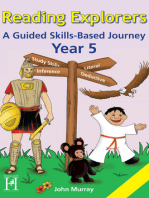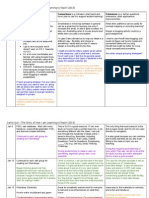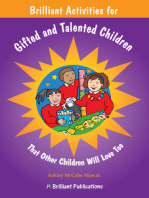Carrie Sun - The Story of How I Am Learning To Teach: Explore First, Explain Later
Uploaded by
api-285245808Carrie Sun - The Story of How I Am Learning To Teach: Explore First, Explain Later
Uploaded by
api-285245808Carrie Sun The Story of How I Am Learning to Teach
Insights
My Major Insights from this Semester/Year
DESCRIBE WHERE THESE INSIGHTS
CAME FROM
How will I use these insights in the future in my
first week of teaching or in another setting in the
future
What will I actually do?
Provide specific examples linked to
my first week of teaching or teaching
in another setting that I describe
Explore First, Explain Later
I now attempt to teach everything from an Explore
First, Explain Later standpoint, and there is no other
way I can think of when I structure a lesson!
Safety P.O.E. with the egg might be a
good one to include in the first 4 days.
I first learned about this approach to teaching
from Cathy Christies BIOCURR class. At first
I was aversive to it and I was sceptical. I
thought it was a good idea, but would only
work with some students, cuz students may
not know what theyre looking for, or they
might miss fundamental concepts, etc.
As time went on, and I got more and more
used to the idea, I realized that this way of
learning actually made a lot more sense than
what education typically has done. I also
thought back to the things I enjoyed learning
about and things that I remember learning
about, and I realized learning was so much
more meaningful when I, as the student,
uncovered stuff and understood stuff, instead
of the notes the teacher gave me.
Allowing choice right from the beginning
Throughout my educational career + more
insights from BIOCURR class
Other ways to incorporate it include:
Reebops might also be good to include,
or any other long-term activities (e.g.
growing or building your own plant, bird
beak and food evolution activity, Oh
DEER, etc.). (But is dependent on what
the students choosing to do first/ what
course it is).
Making notes/record of learning together, or
allowing the students to do it themselves
(e.g. on walkabouts, or carousel type
activities
P.O.Es are a good type of Explore First,
See What I will do the First 4 days
Explain Later activity that still has more
facilitation led by the instructor. This can be a table for more details.
great way to get the class used to this kind of
learning, instead of the passive copy down
notes and then try to consolidate it learning.
Its kind of like a mini Explore First Explain
Later.
Independent or collaborative reflection and
research activities. Students can use their
bio blogs or math journals throughout the
course to uncover and learn about a focus
topic, then we have a day where we share
our learnings together (kind like the what is
science activity we did in BIO CURR)
I have always been a big fan of choice and allowing
students to how they want to demonstrate their
learning, or what topic they want to focus on next, or
even what day they want their test to be on.
I will probably include the ranking of the
questions at the beginning of the year,
on one of the first days. I will continue to
give choice throughout the course in
various aspects.
Carrie Sun The Story of How I Am Learning to Teach
I never thought you could also enhance their
choices by also allowing them to select questions
they find most interesting about the course and
ranking them.
See What I will do the First 4 days
table for more details.
I kinda did this when I was a residence don for 2
years, where I had open forum during my floor
meetings and students could say what kind of
programs they wanted to do over the year. Students
could also let me know casually. I also had a chart
paper near my door where they could write down
what they wanted to do this year but it wasnt very
successful for some reason no responses
throughout the year LOL
Rewards, praise, and motivation
I have learned so many amazing insights
about these topics that have really exercised
and challenged my brain this year.
Alfie Kohns mind-blowing research tells us
that rewards and praise decrease intrinsic
motivation and increase extrinsic motivation.
(learned from CURR BIO class)
However, Carol Dwecks research suggests
praising for effort can also do wonders for
students mindset and performance (as
opposed to praising for intelligence).
I also did my action research on how the
Pokemon Badge reward system seemed to
motivate my junior grades amazingly for math
class.
I am now thinking back to all my activities and
Pokemon Badge reward systems in class and in
residence, and I wonder: I DID EVERYTHING
WRONG!!!
Although it appears my Pokemon Badge reward
system is sucking the intrinsic motivation out of my
students, I am so reluctant to let it go!
It may be good to still have a little bit of both, or to
do it for students individually or privately.
I think I might keep it and adapt it, especially for the
younger grades, because I see the progress and
the excitement the students have during this
program, and I dont think it can be all bad? It may
be good to still have a little bit of both, or to do it for
students individually or privately.
Each student does have their own individual
pokemon card its not like it is on public display.
In terms of older grades, I think the reason it didnt
work very well is because the prizes were not of
incentive to them. They were all very interesting in
I think I want to show that excerpt to my
students at the beginning of the year,
and have them do a reflection of it in
their bio blog/math journal. I could
maybe also incorporate it into their
profile and intro letter, so I know what
each of their personal opinions are about
rewards for example, if most of the
students really like it, I will incorporate it,
but if most students were blown away by
it and want to try learning for the sake of
learning, we will not do it, and just do
things without it.
See What I will do the First 4 days
table for more details.
Carrie Sun The Story of How I Am Learning to Teach
just passing, but doing minimal work to do so.
Maybe an adaption I could do is bonus marks? (if
thats allowed in my board).
Minds-on activities
We learned the concept of these type of
activities from MATH CURR class. They are
basically quick and engaging beginning-ofclass activities that allow to students to have
something to do while relevantly learning or
practicing their skills. It also helps if the
teacher needs time at the beginning class to
sort through paperwork, hand back stuff,
check homework, etc. Students can also use
the time to hand in THEIR homework, ask
questions to teacher, etc.
Collaborative or Independent Backward
Design
We learned how to do this in both my BIO
CURR class and my MATH CURR class, but
we focused on it more in the MATH CURR
class.
One of my favourites that I learned (and that I have
modified and adapted many times to fit the subject)
is the 4 4s sticky note activity. On the board,
numbers 1-20 are in a grid, and each student is
given sticky notes and the goal is try to find a
mathematical operation that is true for each number,
but only using 4s! And only one sticky note per grid
square!
I will try to incorporate these activities
throughout the course, and not just in
minds-on style, but also consolidation
style and to help explore new concepts.
See What I will do the First 4 days
table for more details.
I love this game, I have used it for diversity of life
unit (try to fill in all the kingdoms of life with
species), and the polynomials and powers unit (find
a true power using exponent laws to get a certain
number) (e.g. the board says x36, sticky note can be
x 6+6 or (x6)6)
Although it seems really hokey, it is a good idea.
When I am teaching in the future, I probably wont
do it so formally, but I might use this method to
make a skeleton draft of planning my units in the
course. Planning using backward design allows me
to focus on enduring knowledge and the big ideas
and structure the units so it always comes back to
that. Also it can act like a map with many
destinations, which is what I like to think of learning
an adventure.
See What I will do the First 4 days
table for more details.
What I plan to do each day for the first 4 days and why
Da
y
What will I do
Rationale
Teepee shuffle game
Level 1: arrange themselves alphabetically by first name by themselves without my help.
STUDENT CENTRED CLASSROOMSTUDENTS ARE RESPONSIBLE and must
Carrie Sun The Story of How I Am Learning to Teach
Level 2: arrange themselves by last name without talking, without my help.
Fact or Fiction game using the Raccoon circle
Students stand in a circle and hold on to a part of the circle and start shuffling it. When the
knot comes toward their hands, they can choose to stop the shuffling or let it pass. If they
stop the knot, they say a statement about themselves and the rest of the class has to
guess whether it is true or false.
Make your own bio blogs or journals (with Pokemon card, if applicable)
Paper and some art materials will be provided. Students can also pick a starter Pokemon
card and staple it to their blog. Let students know they will be using it for the rest of the
course for various learning activities. (introduce Pokemon badge system if applicable).
Rank questions that you want to focus on
Give student question sheet for the course. Have the students choose what questions
they want to look at for the course (definitive ranking)
Grouping strategy
Stickers or cards
Diagnostic Assessment.
Assign each group one of the top questions. Have them work in a group to complete a
concept or semantic map that answers that question. After done, they hang up the
concept maps around and do a walkabout. They can now use their bio blogs and write
down some of the interesting things they learned (record of their learning)
work together to reach a goal. Fosters
leadership and community.
Casual positive game to help begin fostering
an inclusive classroom community. Also
CHOICE, they can choose to share or not.
Casual positive activity, introduces them to
the idea of reflection and metacognition.
Implement reward system cautiously, and
only if junior grades, or offer modified version
for senior grades.
CHOICE, right from the beginning.
Getting them used to the idea of moving
around a lot and working with different
people
PRIOR knowledge and using their reflection
journals. Also kinaesthetic, visual, and
collaborative learning
Homework:
Course outline
Student profiles learning styles inventory, draw themselves?
My introductory letter + ask them to write a letter to me
Letter about the course (with parent and student contact information)
2
Introduce basic classroom routines
Meditation bowl, hand-in bins, reading corner, bio class gallery, etc.
Interference game
Divide class into A, B, and C groups. A must try to get a message across to C (e.g. you
miss 100% of the shots you dont take), while B group in the middle must stop that
Introducing them to routines
A fun community builder game that also
demonstrates a point about respect, loud
noise, and talking over others.
Carrie Sun The Story of How I Am Learning to Teach
message in any way possible)
New groups
Create our classroom understandings contract together
Have groups discuss and write down on a chart paper at least 5 understandings (used to
be known as classroom rules) and 1 consequence that they want the class to have. I
want the students to do it themselves, but to make sure everything is covered, I will put
the following headings:
Respect your self
Respecting others
Respect for the environment (school, classroom, and outside)
Inclusivity
Language
Miscellaneous/ Other
Consequences if there are misunderstandings
After, we place them all at the front, and we decide together the best ones make a master
classroom list. (there will likely be many that say the same thing only in different words)
The egg-eyeball safety P.O.E.
Bio blog entry about any of the activities we did today and what they thought of it.
3
They can now sit wherever they want.
This is where I really differ from Cathy. From
my previous experience interacting with
student discipline and situations (practicums
and residence life), it is far easier to set the
tone from the beginning and handle a
situation later, rather than having to handle a
situation later when a discussion beforehand
was never done. It also prevents the feelings
students might get that they think theyre
being targeted. I allow students to make their
own understandings, because then there are
no misunderstandings later, and students
made it themselves and agreed to it.
This is where they can also think about
whether they do or dont want to do the
Pokemon reward system, or if they want to
make modifications if they do want to do it.
EMPHASIZING safety from the beginning.
METACOGNITION REFLECTING AND
THINKING ABOUT LEARNING. Also
provides me with feedback about their
learning.
WHAT YOU ARE LEARNING AND WHYRELEVANT-INTERESTING
Have the questions they chose in a large font at the front of the class (maybe for the rest
of the unit)
Depending on what unit they decided they wanted to learn about first, and what questions
they wanted to answer, begin a long-term activity that can be revisited throughout the unit
(e.g. Reebops, bird beak and food, Oh DEER, make your own plant, etc.)
Make a note together in the last 15 minutes, as part of their notes/records of their learning
4
Entrance slip Small quiz with about 5-10 questions (including questions from course
outline, learning styles inventory, safety P.O.E., and about the beginning of the learning
activity)
STUDENT CENTRED ACTIVE LEARNING
EXPLORE FIRST
EXPLAIN LATER USING STUDENTS
WORDS AND IDEAS
FORMATIVE ASSESSMENT
Emphasize what you learned, not the mark
Carrie Sun The Story of How I Am Learning to Teach
Take up the quiz in class (assign each student a number so that confidentiality is
maintained)- Have students record the mark on the back in very small font.
Learning activity to continue to answer their chosen questionnotemake test questions
together. (Jigsaw possibly)
Shrinking Island game
Bring a tarp outside. Instruct students that they swim around the tarp until instructor calls
out SHARK attack. At this point, students must get on the tarp. All students must have
both feet touching the tarp in order to advance to next level. Each new level, the instructor
folds the tarp in half. Eventually, it will be so small, and the only way to get everyone
touching, is if they SIT down and rest their feet on it.
Ball game
Students stand in circle. Instructor brings ball. Instructions: In order to complete the game,
Each student must say their own name at least once and touch the ball at least once.
(For example, as I toss the ball to XYZ, I say Carrie, and XYZ says their own name and
tosses it to someone else and so on until everyone).
After first completion, Instructor says to group: that was great, but not the world record.
Can you beat it?
The students will go as fast as they can in a circle, but they will keep not getting it. Until
somebody figures out: they can touch the ball all at once and say their name all at the
same time.
Collaborative Learning
Fun, engaging, Problem-solving/Criticalthinking/ Innovative-thinking/ Teamwork skills
You might also like
- Lion - Beaver - Otter - Golden RetrieverNo ratings yetLion - Beaver - Otter - Golden Retriever3 pages
- How to Teach Anything: Break Down Complex Topics and Explain with Clarity, While Keeping Engagement and MotivationFrom EverandHow to Teach Anything: Break Down Complex Topics and Explain with Clarity, While Keeping Engagement and Motivation4.5/5 (4)
- The Guide to Acing Math and Science While Building a Straight-A Study RoutineFrom EverandThe Guide to Acing Math and Science While Building a Straight-A Study RoutineNo ratings yet
- From Learning Disabled to Special Learner--Proven Method: Learning Disability Help, #2From EverandFrom Learning Disabled to Special Learner--Proven Method: Learning Disability Help, #2No ratings yet
- Quick and Easy - How to Make an "A" - In a Nutshell: No More Questions Unanswered!From EverandQuick and Easy - How to Make an "A" - In a Nutshell: No More Questions Unanswered!No ratings yet
- How to Study Effectively - FAST, EFFICIENT, EXAM-READY: NUGGETS OF KNOWLEDGE, #5From EverandHow to Study Effectively - FAST, EFFICIENT, EXAM-READY: NUGGETS OF KNOWLEDGE, #5No ratings yet
- The Teaching Game: A Handbook for Surviving and Thriving in the ClassroomFrom EverandThe Teaching Game: A Handbook for Surviving and Thriving in the ClassroomNo ratings yet
- Exam Literacy: A guide to doing what works (and not what doesn't) to better prepare students for examsFrom EverandExam Literacy: A guide to doing what works (and not what doesn't) to better prepare students for examsNo ratings yet
- The Official Quest for Success Study Guide: Secrets and Strategies to Succeed in the ClassroomFrom EverandThe Official Quest for Success Study Guide: Secrets and Strategies to Succeed in the ClassroomNo ratings yet
- Dr. Cliff's Notes On A Simple Studying Method That WorksFrom EverandDr. Cliff's Notes On A Simple Studying Method That WorksNo ratings yet
- The VESPA Handbook: 40 new activities to boost student commitment, motivation and productivityFrom EverandThe VESPA Handbook: 40 new activities to boost student commitment, motivation and productivityNo ratings yet
- Teaching English to Young Learners Collection: ESL Classroom Management Tips, ESL Activities for Preschool & Kindergarten, 501 Riddles & Trivia QuestionsFrom EverandTeaching English to Young Learners Collection: ESL Classroom Management Tips, ESL Activities for Preschool & Kindergarten, 501 Riddles & Trivia Questions5/5 (1)
- Fifty Ways to Be a Better Student: Tips for College and University StudentsFrom EverandFifty Ways to Be a Better Student: Tips for College and University StudentsNo ratings yet
- How to Study: The Program That Has Helped Millions of Students Study Smarter, Not HarderFrom EverandHow to Study: The Program That Has Helped Millions of Students Study Smarter, Not Harder3.5/5 (14)
- Organizing the Disorganized Child: Simple Strategies to Succeed in SchoolFrom EverandOrganizing the Disorganized Child: Simple Strategies to Succeed in School4/5 (13)
- Brilliant Activities for Gifted and Talented Children: Brilliant Activities for Gifted and TalentedFrom EverandBrilliant Activities for Gifted and Talented Children: Brilliant Activities for Gifted and Talented4/5 (2)
- Standard 3.2 - Plan, Structure and Sequence Learning ProgramsNo ratings yetStandard 3.2 - Plan, Structure and Sequence Learning Programs3 pages
- The Seven Year Education Itch: Adult Learning in Vocational TrainingFrom EverandThe Seven Year Education Itch: Adult Learning in Vocational TrainingNo ratings yet
- The Shrewd Student: How to Study Smarter and Get Great Grades in CollegeFrom EverandThe Shrewd Student: How to Study Smarter and Get Great Grades in CollegeNo ratings yet
- Basic Brainstorming: The Start of the Creative Thinking ProcessFrom EverandBasic Brainstorming: The Start of the Creative Thinking ProcessNo ratings yet
- Certificate of Qualification and Registration: Penghui Sun, OCTNo ratings yetCertificate of Qualification and Registration: Penghui Sun, OCT1 page
- Introduction To Diversity of Life Lesson Plan - Day 1No ratings yetIntroduction To Diversity of Life Lesson Plan - Day 15 pages
- 2010 Newsletter February 11 - Curated by Penghui SunNo ratings yet2010 Newsletter February 11 - Curated by Penghui Sun6 pages
- Detailed Lesson Plan (DLP) Format: Gabayan NG Pagkatuto: CodeNo ratings yetDetailed Lesson Plan (DLP) Format: Gabayan NG Pagkatuto: Code15 pages
- Masagana High School: Cot-Rpms Observation Notes FormNo ratings yetMasagana High School: Cot-Rpms Observation Notes Form4 pages
- TKT: CLIL Part 1: Cognitive Skills Across The Curriculum - Trainer's NotesNo ratings yetTKT: CLIL Part 1: Cognitive Skills Across The Curriculum - Trainer's Notes6 pages
- Star Observation Rubric: (Focus and Observe Closely On The Context of Lesson Plan and Teaching Contents)100% (8)Star Observation Rubric: (Focus and Observe Closely On The Context of Lesson Plan and Teaching Contents)2 pages
- Optional Public Administration 3 Theories of AdministrationNo ratings yetOptional Public Administration 3 Theories of Administration15 pages
- Basic Concepts, Theories, and Principles in Assessing Learning (Alternative Methods)0% (1)Basic Concepts, Theories, and Principles in Assessing Learning (Alternative Methods)13 pages
- Validation of The Brazilian Version of The Hinting Task and Facial Emotion Recognition Test (FERT-100) Schizophrenia 2021No ratings yetValidation of The Brazilian Version of The Hinting Task and Facial Emotion Recognition Test (FERT-100) Schizophrenia 20219 pages
- Graduate School Curriculum Vitae Procedures and Sample: PurposeNo ratings yetGraduate School Curriculum Vitae Procedures and Sample: Purpose3 pages
- Top 7 Leadership Templates and ChecklistsNo ratings yetTop 7 Leadership Templates and Checklists27 pages
- ABELLANO - MAcctngPRe05 Prelim ExaminationNo ratings yetABELLANO - MAcctngPRe05 Prelim Examination2 pages
- Scientific Studies of Mind, Matter, Spirit and Consciousness Ver 3.0No ratings yetScientific Studies of Mind, Matter, Spirit and Consciousness Ver 3.093 pages
- Dsc-05 Understanding Mental Disorders UpdateNo ratings yetDsc-05 Understanding Mental Disorders Update162 pages

































































































